Interact with Shawn Hamilton on our forum here.
Throughout 2020 grahamhancock.com has been presenting the “Kásskara” article series that details the history of North America’s Hopi tribe from the perspective of Oswald “White Bear” Fredericks. As a recognised member of the Hopi Clan of the Bear, whose members currently serve as the tribe’s historians, White Bear acted as the primary consultant for Frank Waters’ Book of the Hopi and also a 1979 book published in German by NASA engineer and émigré, Josef Blumrich, entitled Kásskara und Die Sieben Welten (Kásskara and the Seven Worlds).
The initial Nexus article (03/18) explains more fully my relationship to White Bear and how my high school anthropology teacher, Henry J. Denny, arranged for me to visit him during successive summers in 1977 and 1978. We visited White Bear at his Sedona, Arizona home, and he escorted us to various archaeological sites including local cliff dwellings, petroglyphs at Inscription Canyon, and the astonishing ruins at Mesa Verde, Colorado.
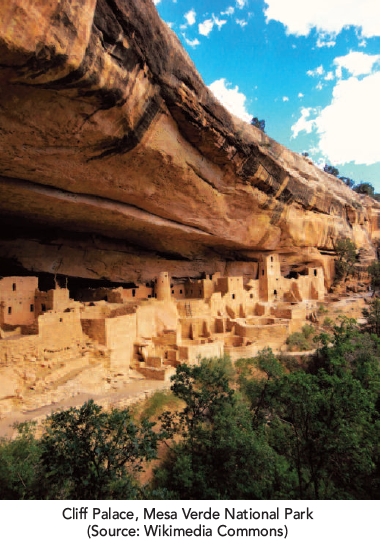
‘Cliff Palace’ by Rationalobserver (CCBY-SA4.0)
As I explain in subsequent articles (04/25, 06/25, 09/02), White Bear’s version of Hopi history does not generally accord with current anthropological consensus, yet his explanations derive from authentic sources and should not be lightly ignored. He refutes the belief that Hopi ancestors originally crossed the Bering land bridge and trekked south, insisting that the Hopi’s previous homeland, Kásskara, lay in the Pacific Ocean, mostly below the equator although the Hawaiian Islands are a remnant. The familiar Hawaiian term “kahuna” has the same origin and carries the same meaning as the Hopi word “kachina”, referring to a highly esteemed being with supernatural attributes. When the Hopi ancestors first came to North America from far south, an ice sheet near today’s US-Canada border blocked their further passage north.
The Hopi weltanschauung involves a series of “worlds”, or cycles of human civilisation, that develop and then are periodically destroyed by cataclysms. The First World, Tokpela, was destroyed by fire. Tokpa, the Second World, was destroyed by ice. The Third World was Kásskara, which sank. Humanity is currently in the Fourth World, Toowakachi, which has yet to play out this patterned cycle. White Bear said the Second and Fourth Worlds both developed on what we today call the South American continent, which had partially submerged and reappeared over a long period. While the time scales involved remain vague, it’s clear the Hopi believe geological changes can occur much more abruptly than experts generally believe.
White Bear’s account, which accords with Plato’s Atlantis story, describes a war between two great civilisations: Kásskara (‘The Mother Country’ or Lemuria) and Talawaitiqua (‘Land of the Morning Sun’ or Atlantis), which had lain far to the east of Kásskara before sinking into the sea.
Kásskara was also sinking, but more slowly, allowing refugees time to flee. The Hopi ancestors migrated to what is today called Ecuador, Peru, and Bolivia, while large swaths of South America still lay underwater. The initial immigrants arrived by means that the Hopi described as “flying shields” (spaceships) and “big birds” (aeroplanes), while larger groups arrived by boats via a series of islands of which only Easter Island remains above water. The migration spanned centuries, and Hopi tradition holds that their ancestors had been helped to migrate by those advanced beings called “kachinas”.
Describing life in Kásskara, White Bear explained that all the power and energy people needed came from the sun, a universal source not dependent on electric lines. Although he said he didn’t understand how it functioned, he described this energy and devices that were used to direct it in ancient times:
“We had an appliance – in fact, we had many – with a crystal inside not longer than an inch. In those days people did not have to work the stone with a graver. All they had to do was to direct the appliance towards the sun and they could split the stone with solar energy. Sounds were recorded in crystals. All the recordings of the Third World are in a cave in South America. My grandmother told me this one day, but nobody knows anymore where it is, he said, claiming that if the cave were to be discovered, he could recognize everything inside.”
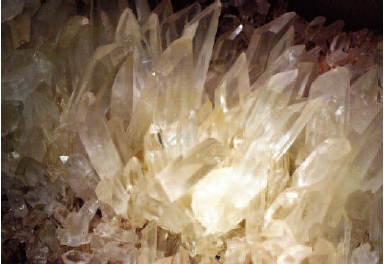
(PD0)
“When we came to this continent, we of course took along these appliances like all our knowledge. In South America, people were able to lift enormous blocks of rock without touching them by tightening the hands. Today one is surprised and does not understand how people could build such big cities, but at the time it was easy. The greatest capacities of the human being lie in the fingertips. They can emit and absorb a lot of energy. Think of medicine men who place their fingers on your body and feel the vibrations. They also feel the vibrations that should not be there and thus locate disease. At some point, mercury was used, but I don’t know exactly how. According to our tradition, there are two kinds of mercury: one liquid, the other solid. There must be a relationship between heat and balance, but I do not know, from the scientific point of view, if it means something.”
The first great settlement, Táotoóma (Tiwanku) may have been originally built closer to sea level. White Bear maintains that its current position in the upthrusted Andes, above the tree line, indicates the settlement’s great age. He said the initial migrations from Kásskara began about 80 “soomody” ago, or 80 thousand years. After Tiwanaku was destroyed by a massive explosion, groups migrated north to Palátquapi (the Red City), today called “Palenque”. He described a great structure there – a combined school and temple – explaining how the building’s pyramidal construction represented expanding or unfolding knowledge.
“It symbolises the rising upwards towards higher levels of the spirit and increasing comprehension of the world’s miracles. According to our tradition, such a building also existed at Táotoóma,” White Bear said.
The Kachinas performed the teaching and decided who was qualified to attend this school, identifying before their births the children who could lead lives of education, devotion, and abnegation. “Only the Kachinas were able to designate those who could climb in levels and finally reach the last floor of this University of Life. Few achieved this goal. Those who reached that point were in perfect harmony with the divine Creator. This is why I will call them ‘great holy men’,” White Bear explained, recalling a mysterious Hopi seer.
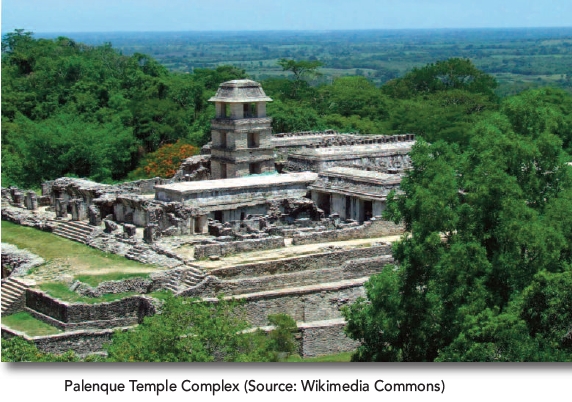
‘Palenque’ Temple Complex by Daniel Armesto (CCBY-SA3.0)
“On this subject, I must speak to you about a man who I had the chance to know named Aápa. He belonged to my grandfather’s clan, the Clan of Badger, and he was one of the great visionaries of our time. Such men are sometimes called medicine men, even by our people, but in fact, they are not. The events that I lived with Aápa, and the things he showed me, were filled with mystery. Often, he used his third eye. One day he told me that people could pass from the physical side of life to the spiritual side – that the border between the two is barely perceptible. All those who see with their third eye can cross it. Aápa also showed us how one can see the other side of the earth using the moon. He showed and taught us many things that you could not believe without seeing them yourself.
“Aápa did these things in the presence of my parents, and as the oldest son, I could assist him. He said to us that all this knowledge came from the 4th floor of the pyramid temple and was transmitted to his ancestors from whom he received it. Such men devote all their time to the important tasks of walking the narrow path. They are confronted with many dangers and temptations, yet there have always existed men who achieved this high goal. Such a man is called ‘Náquala’, meaning advisor or benefactor, indicating his renunciation and devotion in life for duties towards his people as a guide, for such a man does not let himself divert from the path of truth. To those who had achieved this spiritual goal, the Kachinas granted them the favour of not having to die. They could leave our earth without being dead. That already existed in the town of Táotoóma. These people really left us in their human body towards a planetary system we do not know.
“The Kachinas encouraged us to learn as much as possible to be able to reach the highest rank. They always reminded us that life is in front of us and that we should never forget what we had learned in this University. They also told us that one day in the future misfortunes would happen and that we must do everything to remain close to the divine capacity,” White Bear explained.
For centuries the people of Palátquapi remained on the right path, he said. It was a period of universal harmony. After some time had elapsed certain clans started to leave and settle elsewhere. As new colonies formed and people moved away, they had decreasing contact with their teachers, the Kachinas, and those people who had reached the highest level of that University were sent as delegates to these new colonies.
“They used their third eye to choose young people to whom they could transmit their knowledge. Eventually, many colonies lost contact with our guides and left the right path. Within the clans, and between the various clans, disputes arose that resulted in the clans separating. Increasingly, people left Palátquapi for Central America and Yucatán where they built cities and created great civilisations. Again, however, a time occurred when even spiritual guides chose the side of the malicious ones and left the right path,” White Bear explained.
The most important clans that left Palátquapi were the Clan of the Snake and the Clan of the Bow (or Arc) although important elements of each had remained there, and it was these people who continued to obey the laws of the Creator. White Bear detailed the structure of Hopi clans so we may better understand the repercussions of such a schism:
“Let’s take the Clan of the Snake as an example. Like all the clans, the Clan of the Snake is composed of several groups. In their case there are six groups also called clans because the snake has six heads. The highest group in the Clans of the Snake is the Kaátoóya Clan. Kaátoóya is the snake that represents the direction west implying sunset or death. According to the tradition of the Clan of the Snake, Kaátoóya is the most important snake because it is he who pronounces the verdict when we leave the earth. Now you can see how we use and speak about symbols. People think we do not know anything else, but this is false because we know the meaning behind the symbols. In this case Kaátoóya is the most important divinity of the Clan of the Snake, but we speak about him as if he were a snake. The clans that started from Palátquapi built many cities, and they will provide evidence of our traditions. Some of these cities have been found, but more will be discovered in the future. The capital of the Clan of the Bow was the great center at Tikal [Guatemala].”
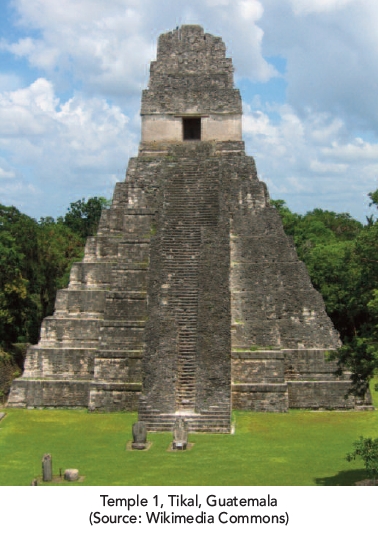
‘Tikal’ Pyramid by Raymond Ostertag (CCBY-SA2.5)
I note that more has been found! In a Nexus magazine article of September 2017, White Bear is on record saying more would be discovered in Tikal. In September 2018, Science magazine published an article announcing that LIDAR technology had exposed hundreds of previously unknown dwellings under the jungle canopy there. The discovery’s announcement strengthens White Bear’s credibility although I note he originally made these claims during the late 1970s.
Palátquapi had always been the true center of this civilisation, and the other cities in Central America and Yucatán were secondary sites. Emigration weakened the power of Palátquapi, however, and its chiefs eventually determined that war was inevitable. At the same time, many of the clans remained committed to traditional beliefs and remained in Palátquapi.
“They were the elected people. When the initiated people of very high rank felt the danger, they went to other cities in order to obtain a reunification, but they could not influence them anymore. During those terrible times in Palátquapi and Yucatán, the Kachinas left us,” White Bear said. “They have not been with us since then, and all we can do is follow their example.”
He acknowledged that we might wonder how Palátquapi and Yucatán could suffer misfortune despite the Kachinas’ presence, explaining that each time something of that nature had happened in the past, it had been caused by the actions of people themselves rather than the Kachinas. The Kachinas had warned them, but the majority of men wanted to conquer and make war. They continued to violate the Creator’s laws, and this is why many of the clans and people were destroyed. While the clans were fighting, the Kachinas did not interfere because the Earth belongs to men.
“What men do, they do it to themselves, and they will undergo the consequences of it. The day of punishment is not here yet, but it approaches. Since that war, much time has elapsed, and our people walked a lot to finally arrive here on our land. But we always keep alive the memory of all the events that occurred, even if members of some Hopi clans don’t like to remember them,” White Bear observed. “I want to tell you a story because evidence of it has been found in the form of drawings and sculptures.”
White Bear Relates the Story of a Technological War Between the Clan of the Snake (Yucatán) and the Clan of the Bow (Tikal)
“As I’ve mentioned, a schism had occurred among the spiritual guides. Some wanted to continue to teach and educate the young people in harmony with our important spiritual heritage. The Clan of the Snake formed part of it, but others like the Clan of the Bow did not want to continue this way. This clan had already acted similarly when it took part in activities that led towards the destruction of the Third World. These facts are known by the Hopis.
“We also know the form of energy which was used during this combat. The scientists of many countries now work to develop such weapons. The Clan of the Bow declared that its way of living made its members stronger, and they challenged the Clan of the Snake and other clans. The Snake Clan accepted the challenge.
“The chiefs of the two sides met in order to establish rules of combat. There were important quarrels – like we see today among heads of state. They agreed that the combat should begin two days after the meeting ended and that each side would try, during the four days, to conquer the enemy city. The Clan of the Bow wanted the Clan of the Snake to begin the hostilities, but the latter insisted, ‘No, you challenged us. You, therefore, must start,’ and that became the agreement.
“The combat was to begin each day at sunrise and finish when the sun touched the horizon. It was not a war where one fights man against man with bludgeons or bows and arrows. The cities were separated by many kilometers and it was a scientific or technological war between two very powerful groups. This is why the two clans do not like to speak about it even today.
“During the two following days, all the preparations were undertaken, and on the third day at dawn, the combat started. The Clan of the Bow bombarded the Clan of the Snake’s city with the strongest and most destructive weapons it had. What was used relates today to electrical energy, similar to lightning. The Clan of the Snake had prepared for it. The people went underground to protect themselves with a type of powerful electrical shield. The chiefs appeared from time to time, during the day only, and met under a shield to see the sun’s position. It was difficult, and everyone was relieved when the sun set, and everything again became quiet. There was no more thunder caused by the powerful force touching the shield. The shield was removed, and everybody could leave the shelters.
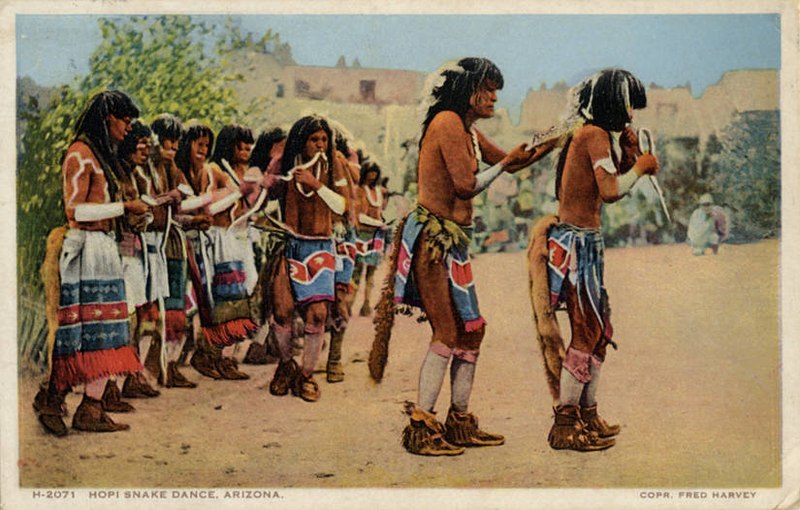
(PD0)
“The Clan of the Bow knew that it had not damaged the rival city and that the Clan of the Snake would retaliate the following day. Now it was the Bow Clan’s turn to prepare for protection. The sun rose and the Clan of the Snake attacked the Clan of the Bow’s city. The Snake Clan’s weapons were so powerful that their blasts resembled atomic explosions! But the Clan of the Bow had a powerful shield. Both sides had made important scientific progress. Therefore, the Bow Clan survived this second day. No decision fell on the third day, and the Clan of the Bow lost its chance for victory. The fourth day arrived, which was the last chance of victory for the Clan of the Snake. It did everything possible but could not break its adversary’s shield. After a few hours in the afternoon, the Snake Clan decided to try something else to demonstrate its power. Shooting ceased, and they used the capacities of the snake to bury themselves, building a tunnel below the fortifications of the Bow Clan.
“People of the Clan of the Bow were astonished when the bombardments stopped before sunset. They wondered if the Clan of the Snake had given up. They were still raising questions when the Snake Clan chief came out of the tunnel and said, ‘We are here, and you are overcome. We could kill you now, but we will not. From now on, however, your divinity, Saáviki, must carry a snake in the mouth at the time of your ceremony every four years.’ This ended the combat.
“In Hopiland there are drawings of a man carrying a snake in his mouth, and at other places, there are sculptures which show the same thing – in Tikal, for example. To keep this memory alive, the divinity of the Clan of the Bow carries a snake in its mouth during the Powámuya ceremony here in Oraibi. This way the Hopis remember what occurred a long time ago in Yucatán.”
The Diaspora
After these turbulent times in Palátquapi and Yucatán, people became completely divided. Palátquapi had not been destroyed by the war. People left when it had lost its power, and it was finally destroyed by an earthquake. Many clans again started to migrate but were isolated from each other. “The Kachinas helped us only by showing us the way. We could not use flying shields anymore. We really had to struggle if we were to deserve to have this new land,” White Bear said.
“Our people moved all over North America. Ruins and tombs on the continent attest to our movements. We are the only people who, even during migrations, built our houses in stone. The Creator wanted it this way. We assembled neither tents nor light huts but built only true houses in which we remained, sometimes for several years, before carrying on. Such settlements or their ruins showed the groups arriving after us that we had passed there a long time before them. Some began the migrations and never finished. Others remained in an area when they found one, they liked.”
“There were only a few groups that always obeyed the laws and transmitted the true traditions. All the others did not have the same religion anymore. They lacked the knowledge although Táiowa had created them all. Our people had an elevated technological level, but they never used the energy to destroy lives. All this knowledge was gradually lost, and people had to work increasingly hard. Today, all these good things have been forgotten, and we see with astonishment what was possible in the past. As a comparison, one could say that today we live in a dark period.”
Casa Grande
Evidence of the clans can be found all over Central and North America. The few clans that continued to respect the laws tried to find spiritual guides because they knew they could not fulfill this role themselves. Some spiritual leaders decided to bring together their clans in order to teach the younger generations the highest level of knowledge concerning the relationship between mankind and the Creator, and finally to transmit to them the traditions which, since the First World, remain alive despite the difficult migrations and times.
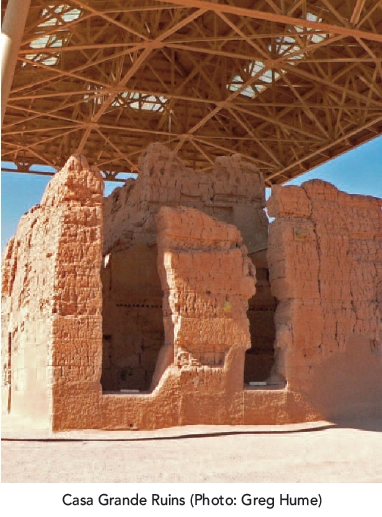
‘CasaGrande’ by Greg Hume (CCBY-SA3.0)
“At that time the marvelous city that one today calls ‘Casa Grande’ was built. I remember well a day when I was still a child. I sat close to my father, and he asked me what I had learned in school. He did not seem satisfied with my answer, so he started to speak to me about this city. Later, when he took me to visit it, I found it exactly the way he had described it to me. However, he had never been to this place, so how could he have described it so precisely? Obviously, others had spoken to him about it many times. It is this way we keep our traditions,” White Bear observed.
Eventually, this city became an important center. Its end arrived when it was attacked by the Clan of the Spider. The clans that lived there defended it courageously, but when the enemy diverted the river that fed the city, they had to give up. They did not capitulate, however, because they had dug a tunnel by which they were all saved. This city was the last great gathering place before the final reunification at Orayvi (Oraibi).

(PD0)
Oraibi is the oldest North American village that has been continuously inhabited since its foundation. Archaeologists have analysed wood used in constructing Hopi houses and determined the original village was created at about 1150 AD, but White Bear said that estimate errs by thousands of years, noting that scientists didn’t realize the buildings they studied sat atop layers of previous villages lying below the exposed ruins.
“Oraibi was not the first village in this area. The first village, called Shungopovi, was founded four thousand years ago. It was at the foot of the cliff of Second Mesa, below the current village which bears the same name”, White Bear explained.
At some point, there was an argument between two brothers regarding a woman. The younger brother, Machito, decided to leave Shungopovi to create his own village, which became Oraibi. Machito, belonging to the Clan of the Bear and knowing all the traditions of his ancestors, brought to Oraibi the most valuable of Hopi possessions – the four sacred boards, which his parents had given him when he decided to create his village.
White Bear explained that several hundred years had elapsed before all the clans that were to arrive had gathered. Long before the creation of Oraibi, the clans planning to settle there had been selected, and even those clans chosen could not come whenever they wished. “Their Kachinas had to say to them, ‘Now it is time for you to go there,’ and then they came,” he said.
Each clan that wished to come to Oraibi had to settle initially within a few miles of the village. The numerous ruins in the surrounding area served as such provisional sites. After some time, the clans could send their representatives to meet the chiefs in order to request permission to settle permanently. They were asked to explain the history of their migrations – where they had gone, what they had done, and whether they had observed the Sacred Laws. Their complete history had to be reported to the leaders of the Clan of the Bear. This clan had authority due to its noninvolvement in Kásskara’s destruction. In order to be accepted, however, it was not enough to have simply finished its migration; each clan was also required to specify how it envisioned its participation in the ceremonies.
“There exists an annual cycle of ceremonies, which is complete only if all the ceremonies of each clan are represented. Consequently, a clan wanting to settle in Oraibi had to contribute to our cycle with its own ceremony. Certain clans could not be accepted although they had the same origin as us because they had not finished their migrations,” White Bear noted. “They settled in the surroundings and today are called the ‘Pueblos’ tribes. Of course, the word ‘pueblo’ is of Spanish origin, and we always gave them their true names, as for example, ‘Si’os’, which are now often called Zuni. Other clans were not accepted for different reasons.”
The Arrival of the Spaniards at Oraibi
“When the Kachinas left they told us not to forget that one day there will be people of another country who will come to see us to speak to us about another belief. They gave to the Clan of the Bear a stick approximately two meters long on which they asked us to mark each year that passed. The stick was black and each year at the time of Soya’l we made a white mark on the stick. When the stick was covered with marks from top to bottom, people of another country would arrive,” White Bear recalled. “The Kachinas had asked us to meet these people at a place called Kowawayma, which is on the Rio Grande about fifty kilometers north of Albuquerque [New Mexico].
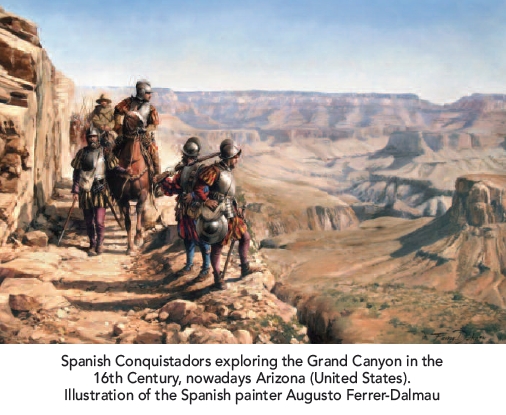
‘La conquista del Colorado’ by Augusto Ferrer-Dalmau (CCBY-SA4.0)
“If the foreigners did not come that year, we had to add five years on a new stick, and the meeting place, in this case, was ‘Sikia’ova’ (yellow stone). This place is close to the old road towards Oraibi. If, after this time, they were still not there, we had to meet them five years later at a higher place on the road which is called ‘Chiwachukha’ (hardened clay). After another five years, we were to meet them at a place called ‘Nahuuyangowasha’, (cross fields). After five more years the last meeting place had to be on the edge of a cliff east of Oraibi. The name of this place is ‘Táotoóma’.
“When the first stick was filled, Pahana had still not come. In this way, many years passed. According to our tradition, Pahana is ‘the brother’ who would lead these people to our continent. Pahu means ‘water’, but we do not pronounce it entirely; we contract it and say only ‘Pa’. The syllable ‘ha’ means ‘journey on the water’, suggesting a boat. Pahana is thus ‘the man who crosses water in a boat’, which shows that several millennia before the event, it already was known that people would come in boats and not on flying shields as in ancient times.
“Our people started to become concerned as years passed and nobody arrived. The great delay suggested that the visitors might not be who they had been expecting. Finally, after a delay of twenty years, the Spaniards arrived, and the Hopi prepared to meet them. You recall that a city called Táotoóma (Tiwanaku) was also the part of the continent that emerged from the water (South America). The foreigners arrived at this place in North America, which bore the same name. A long time ago Táotoóma meant ‘new beginning’, and also meant a new beginning on this occasion.
“Our old people and the religious leaders came to wish them welcome. The foreigners carried armor and all their weapons, but we were not afraid. We still thought that they were brothers, civilised human beings. Then the tragedy started. The chief of Oraibi tightened his hand for a ‘nackwach’ – the sign of true fraternity. If the man opposite had understood this sign, all would have been well, but when the chief tightened his hand, the Spaniard believed that he wanted a gift and insulted the elder by giving him worthless trinkets.
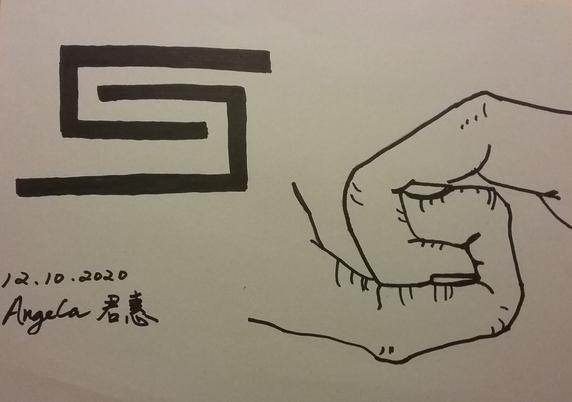
Symbol of the Nackwach handshake by Chun-Hui (Angela) Hamilton
(Left) Petroglyphic representation of the Nackwach symbol. (Right) Approximation of actual human-to-human handshake. Note how the “Nackwach handshake” resembles the Asian Ying/Yang symbol
“It was a hard blow for the Hopi, the foreigners not knowing the sign of fraternity! Our people realised then that as from that moment, misfortune would befall us. That occurred, and we are living it.”
Conclusion
As this series concludes, I offer a couple of final thoughts regarding this subject, which I have lived with and incorporated into my world view since I was a teenager. An important conclusion I’ve drawn involves the notion that modern civilisations are not necessarily superior to those of aboriginal cultures, and in significant ways, they may be vastly inferior.
General observation teaches us that nature operates in cycles, so it shouldn’t be too difficult to consider as possible White Bear’s assertion that mankind has developed advanced technological civilisations in the distant past. Modern man seems to be locked within a 10 thousand year time bubble that causes us to misidentify all scientific discoveries as novel. Thus, we fail to recognise and appreciate the scope of ancient knowledge that has accumulated over vaster spans of time.
“We all live at crossroads,” Graham Hancock once noted before reading an excerpt from an ancient text called The Asclepius. “There’s no doubt. We all feel it. We all know it. I don’t think it’s the first time that mankind has stood at such a crossroads. But here we are now, facing it, and hopefully dealing with it.”
Hancock implies that Hermes’ prophetic description of Egypt’s decline bears striking resemblance to modern times. I feel impelled to note that Hermes’ warning to mankind also sounds awfully similar to Hopi prophecies.
“It’s Hermes speaking,” Hancock explains, “And he’s saying to Asclepius this:”
“Do you know, Asclepius, that Egypt is an image of Heaven, or to speak more exactly, in Egypt all the operations of the powers which rule and work in Heaven are present in the Earth below? In fact, it should be said that the whole cosmos dwells in this our land as in a sanctuary. And yet, since it is fitting that all wise men should have knowledge of all events before they come to pass, you must not be left in ignorance of what I will now tell you: There will come a time when it will have been in vain that Egyptians have honored the Godhead with heartfelt piety and service, and all our holy worship will be fruitless and ineffectual. The gods will return from earth to heaven, Egypt will be forsaken, and the land that once was the home of religion will be left desolate, bereft of the presence of its deities.
“Oh! Egypt! Egypt! Of thy religion nothing will remain but an empty tale, which thine own children in time to come will not believe. Nothing will be left but graven words, and only stones will tell of thy piety. And in that day men will be weary of life, and they will cease to think the universe worthy of reverent wonder and worship. They will no longer love this world around us – this incomparable work of God, this glorious structure which he has built! This sum of good made up of many diverse forms. This instrument whereby the will of God operates in that which he has made, ungrudgingly favoring man’s welfare – this combination and accumulation of all the manifold things that call forth the veneration, praise, and love of the beholder. Darkness will be preferred to light and death will be thought more profitable than life.
“No-one will raise his eyes to Heaven. The pious will be deemed insane, the impious wise. The madman will be thought a brave man, and the wicked will be esteemed as good. As for the soul and the belief that it is immortal by nature – or may hope to attain immortality – as I have taught you, all this they will mock and even persuade you that it is false. No word of reverence or piety, no utterance worthy of Heaven will be heard or believed. And so the gods will depart from mankind – a grievous thing –and only evil angels will remain who will mingle with men and to drive the poor wretches into all manner of reckless crime – into wars and robberies and frauds and all things hostile to the nature of the soul.
“Then will the earth tremble and the sea bear no ships. Heaven will not support the stars in their orbits. All voices of the gods will be forced into silence. The fruits of the earth will rot. The soil will turn barren and the very air will sicken with sullen stagnation. All things will be disordered and awry. All good will disappear. But when all this has befallen, Asclepius, then God the creator of all things will look on that which has come to pass and will stop the disorder by the counterforce of His will, which is the good. He will call back to the right path all those who have gone astray. He will cleanse the world of evil, washing it away with floods; burning it out with the fiercest fire; expelling it with war and pestilence. And thus he will bring back His world to its former aspect so that the cosmos will once more be deemed worthy of worship and wondering reverence, and God, the Maker, and Maintainer of the mighty fabric will be adored by the men of that day with continuous songs of praise and blessings. Such is the new birth of the Cosmos. It is a making again of all things good, holy and awe-inspiring restoration of all nature, and it is wrought inside the process of time by the eternal will of the Creator.”
A version of this article has also been published by NEXUS magazine, October 2019









This article is the fifth and final instalment of the “Kásskara” article series that details Hopi history through the eyes of elder Oswald “White Bear” Fredericks who I was introduced to as a teenager in the 1970s.
You can find links to the entire series Kásskara series here:
Kásskara: Sunken Land of the Hopi Ancestors by Shawn Hamilton 18th March 2020
Earth Cataclysms And The Hopi Kachinas, Saviours From Space by Shawn Hamilton 25th April 2020
The Mysterious Past of the Hopi: From Kásskara to the Americas by Shawn Hamilton 25th June 2020
Legacy Of Kásskara: Hopi History, Spirituality And Symbolism by Shawn Hamilton 2nd September 2020
Hopi History: Hi-tech Clan Warfare in the Americas by Shawn Hamilton 16th December 2020
This is a fascinating read, thank you for sharing it!
creation and destruction go hand in hand cannot have one without the other. thats life cruel as it is
Hayden,
You’re right although I’m not sure, specifically, how your observation relates to the article.
There is no construction without destruction of another object…you cannot make anything from nothing. Change is the only constant and perhaps that too, shall pass away from within our own existence.
the gods must be crazy to start what ever it is they started, creator started all this nonsense of destruction and creation it only has itself to blame for wanting to create what it did then let it run like a crazy experiments the god or gods are crazy.
Also why is this so called crazy creator god always a “HIM OR HE”. should be a “thing” or a “it” cause no one has actually seen this god that everyone goes on about.
Probably because we’re using the left hemisphere for logical reasoning and ignoring the master located in the right hemisphere of intuitive knowledge and awareness. You can thank the alpha bet for shifting us into the left side of the brain and the resulting Patriarchy.
Why should we suffer? If man is the creation of god, god must be a rather horrible entity, a monstrous entity that is making human beings go through hell. Right? He must be total disorder because we live in disorder – if he created us. If he created us and we are killing each other through terror, bombs, kidnapping – oh, you know all the terrible things that are happening in the world. If you are created in his image, that image must be monstrous. Obviously it is quite evident that man is responsible. Nobody outside of us, no gods, no angels, no Brahman, no higher – none of that is responsible for this, we are responsible. And what is the cause of this? You understand now? Is the cause selfishness? https://jkrishnamurti.org/de/content/why-there-such-chaos-world
I’m not the only one who realised this ABOVE QUOTE point is, for there to be any creator god or gods then they most be monstrous entity’s.
very interesting articles but from what i have studied of geology when i was at university there are two mechanisms involved in geology processes that i learned… gradualism and catastrophism geology, im not sure where the view opinion of only gradualism geology happens…..
“Today, the dispute between gradualism and catastrophism is largely over, as scientists recognize that both gradual and sudden processes have shaped the surface of Earth and the course of biological evolution”.https://www.encyclopedia.com/science/science-magazines/earth-science-gradualism-and-catastrophism
“The few clans that continued to respect the laws tried to find spiritual guides because they knew they could not fulfill this role themselves.”
searching for spiritual priests gurus etc is the first problem in the first place, people placing there power onto another so themselves lose power by giving it to others to manipulates. Look at the thousands of years of this social order of so called spirit priests who get all the riches and control they want…Aztec priesthood using human sacrifice as control, Hindu with its caste system its priestly order at the top, the pope, the Islamic clergy and now manipulated science is a priestly order the list is endless.
I don’t need no spirit priest to tell me how to be good etc if ya cannot do that yourself then you will have problems.
Interview with Book of the Hopi author Frank Waters (November 1964)
https://www.youtube.com/watch?v=0b_K4XNfLxY
Thank you, Shawn. Your narrative on the ancient American civilizations is quite fascinating and readily meets our synthesis promoted by our research on Vedic Civilizations in Asia. We, a group of mathematicians, are engaged in the actual history of mankind and so far we could trace six superior civilizations flourished and perished during the past one million years of earth’s history. Please use this one example from Mario Buildreps, a scientist from Europe, that we used as our basis of the Vedic antiquity research: Lost Civilizations and Earth Crust Shifts – https://mariobuildreps.com/lost-civilizations-earth-crust-shifts/.
Thank you very much for these precious informations
Here’s some archival information involving White Bear from Northern Arizona University. Note that the library has a six and a half-foot stack of documents relating to him….
LINK HERE: https://tinyurl.com/yyfu9xb2
Creator: Fredericks, Oswald White Bear
Title: Oswald White Bear Fredericks Collection,
Inclusive Dates: 1953-1965
Quantity: 6.5 linear feet textual materials, approximately 40 audiotapes
Abstract: Correspondence and oral history transcripts concerning Oswald White Bear Fredericks’ work on Book of the Hopi (1964), including correspondence with publishers and foundations concerning the projects as well as audio recordings and transcripts of Fredericks’ interviews with Hopi elders.
Identification: NAU.MS.316
Language: Material in English and Hopi
Repository: Cline Library. Special Collections and Archives
Northern Arizona University
Box 6022
Flagstaff, AZ 86011-6022
Phone: 928 523-5551
Fax: 928 523-3770
Biographical Note
Oswald White Bear Fredericks spent most of his life as a Hopi artist and story teller working for various youth organizations. One of his accomplishments was the carving of the Goldwater Kachina Collection which now resides at the Heard Museum in Phoenix. His second major accomplishment was collecting oral histories of Hopi people. These oral histories were the basis of Frank Waters’ Book of the Hopi (1964).
Fredericks was born in Old Oraibi on February 6, 1905 to Charles and Anna Fredericks. He was christened Kacha Honowah (White Bear) after his father’s Bear clan and was born into the Isngyan (Coyote) clan which was his mother’s. As a child, White Bear was initiated into one of the four societies which all Hopi belonged, however he was never initiated into one of the major four Kiva groups. White Bear attended the Oraibi Day School, was sent to the Phoenix Indian School then on to Haskell Institute in Lawrence, Kansas, and Bacone College in Muskogee, Oklahoma. It was at this latter institution, in 1930, he became a devout Christian. From this point he moved to New York, where he taught Indian Lore to the Boy Scouts. He then became the head instructor for arts and crafts for the YMCA in New Jersey and spent time at Shawnee-on-the-Delaware as a workshop instructor in Indian music.
In 1950 he married Naomi Meltamore (Brown Bear), a German American, from Waukegan, Illinois. After their marriage, they moved to New Oraibi and stayed in the home of his clan aunt, Elizabeth White. Here they took over his Aunt’s business of boarding visitors and researchers. Unfortunately, very few visitors came to lodge with the Bears, so White Bear and Naomi returned to Phoenix in 1952. He returned to work as an instructor of arts and crafts for the Phoenix Boys Club. Because of his talent, he was in great demand for Hopi crafts, especially his Kachina dolls. White Bear remained an instructor until 1959.
It was during the late 1950s that White Bear convinced Fredrick Howell, director of the Charles Ulrick and Josephine Bay Foundation, to underwrite a history of the Hopi people. Howell approved the idea and eventually, Frank Waters was chosen as the writer to work with White Bear.
White Bear’s role in the project was to record and transcribe oral histories gathered from Hopi elders. It is from this information that Frank Waters compiled his “Book of the Hopi” in 1963. The book was quite popular, drawing interest from the public and Hopi alike. Within the book was the myths of the Hopi and general information on their clans and rituals. This book became quite popular with the alternative movements of the 1960’s and led to many pilgrimages to Hopi, and even unwanted settlement. Today, the book still holds favor with the New Age crowd, stimulating pilgrimages to Hopi from all over the world, especially German.
In his later years, White Bear continued his reputation as a top artist and as a teacher of Hopi culture. He shared his art and his knowledge with the world through public presentations in the United States and Europe. For many years he could be found exploring the backcountry of Hopi and the Verde Valley in search of answers to Hopi prophecy. White Bear died on February 6th, 1996.
Thank you so much for this information Shawn! I met White Bear on the Hopi Reservation in the mid 1980’s. When he asked me where I was from and I told him Ohio… he referenced the Native American Earthworks in this area and said that they (Hopi) helped to build the Serpent Mound. Do you know if White Bear spoke about this with others or is it referenced anywhere else? Thank you for any information you can share.
Thanks for connecting, Pam!
Considering what White Bear said (Book of the Hopi), I’ll state that the Ohio Snake Mounds represent artifacts from a cultural group that was part of the overall Hopi migration plan. According to Hopi tradition, various clans were compelled – by the Kachinas – to pursue various directions from a point near Peru. It stretched from the southern tip of Chile to North America, but the overall migration pattern resembled a swastika – the ancient sun sign recognised worldwide and predating its distorted interpretation a la Hitler.
I just ran across some handwritten notes taken by Henry J. Denny, the anthropologist and teacher through whom I met White Bear. I’m guessing Henry drafted these while an Anthropology graduate student in the early 1970s at Northern Arizona University. I mention the “seer” he refers to here (his uncle) several times throughout the Kásskara series.
Original document here: http://theswillbucket.com/?p=145 Transcript:
HOPIS (Hopi means PEACE)
Source material: Oswald “White Bear” Fredericks as told to Henry J. Denny.
1. The spaceship connection: When Bear was approximately 9-10 years old he was with his uncle (a shaman and seer) when…a half-mile long cigar-shaped alien craft appeared overhead at Oraibi, Arizona. [Bear told me that he has had conversations with these “out of earth” visitors. The coming of WW2 is an example (of what the visitors told him ].
2. The mysterious illness that modern doctors could not diagnose or cure. A Navajo chieftain had stolen several horses from the Hopis. His daughter had developed a life-threatening condition. The chief sent his daughter to several known white doctors but none could explain the illness, even with the many tests, x-rays, etc. The Navajo chief heard that White bear’s uncle (the shaman) might cure his daughter. Bear’s uncle knew he was coming, but never looked at the chief as he entered his house. The chief asked [White Bear’s] uncle to forgive him for the theft and pleaded for his daughter’s cure. Bear’s uncle (without looking at him) prescribed the necessary herbs and ingredients that would cure his daughter. She survived and lived a healthy life.
3. A robbery solved with an all-seeing crystal: A gem and jewelry store in Flagstaff was broken into and many valuable jewels were stolen. The Flagstaff police sent their best investigators to the store in hope if finding clues to the theft. After several weeks of investigation, the police and detectives were baffled. The white owner asked Bear’s uncle for help. The shaman brought a large crystal to the store and told the owner to look into the crystal to view the person who committed the theft. The person seen in the crystal was a former employee. After a search warrant was issued the owner recovered his valuable property and the culprit was arrested.
Thank you, Shawn, got the list of the whole series! Really fascinating! Greatly appreciated & refreshing to learn truth than the fiction most often passed off as truth! I really enjoyed this.
I’m wondering if those of us who so desire peace can shift back into it?
Good of you to reply, Cynthia.
Absolutely, yes! It’s happening!
s
I was the person given The Sight on their visit of 9/15/14. They injected Monatomic Gold mixed with some, yet unidentified red gem that was crushed and injected into my Pineal Gland.
“I was the person given The Sight on their visit of 9/15/14. They injected Monatomic Gold mixed with some, yet unidentified red gem that was crushed and injected into my Pineal Gland.” —
Do you know why they singled you out on that date? The procedure you describe sounds plausible but fantastically expensive!
How did it work out?